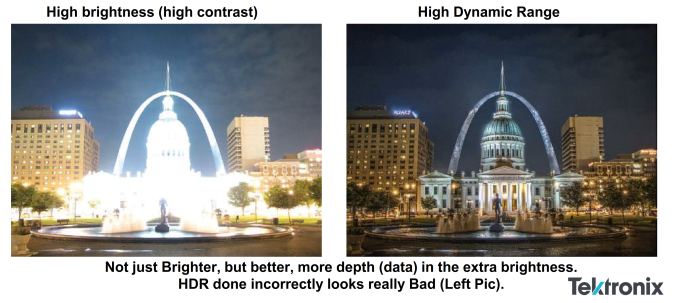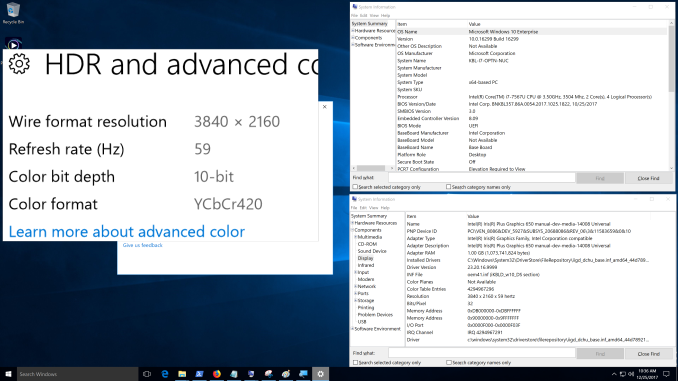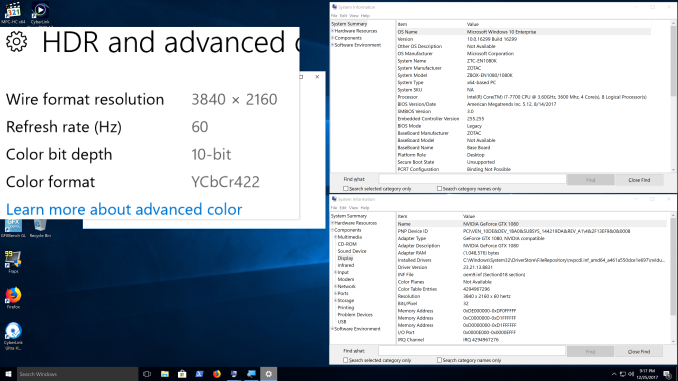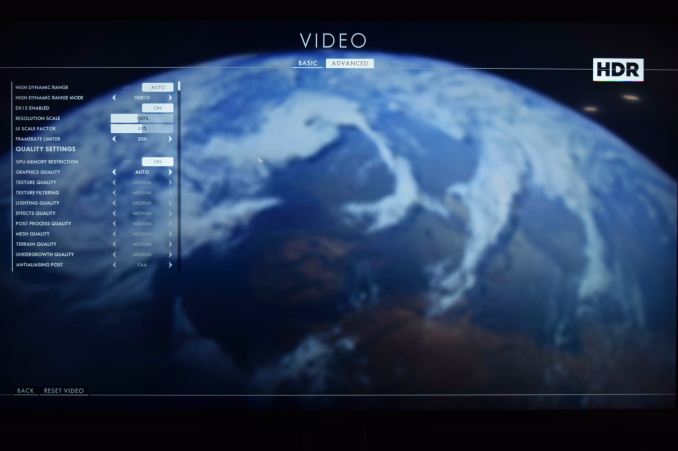A Budget Home Theater & PC Setup: 4K, HDR, UHD Blu-ray, and More
by Ganesh T S on December 26, 2017 8:30 AM ESTHDR Support
High Dynamic Range (HDR) is one of the most impressive features in the recent crop of 4K televisions. In layman's terms, it refers to the ability of a single frame to have wide variation in brightness for different regions. This allows the details in the dimly lit areas of the frame to be seen more clearly. Overall, it delivers a more vivid picture to the viewer. Note that this is quite different from the concept of high contrast.
Picture courtesy: SMPTE HDR Presentation from Steven Holmes of Tektronix
The ability of a display source to transmit HDR frames, as well as that of a display sink to be able to accept and understand them, can be gathered from the HDMI port's specifications. However, being able to accept and understand is only part of the problem. There are many low-cost 'fake HDR' TVs that simply parse the HDR information, but, do not have the ability to translate that to the display.
There are many HDR 'standards', with the base requirement being HDR10. Shifting a display sink into HDR mode involves the source sending some information (metadata) with the characteristics of the video being transported (the mapping of the pixel data to the displayed luminance, light levels in the video stream etc.). If this is static (i.e, done once when the shift to HDR mode occurs), it falls under the HDR10 category. Dolby Vision allows for the metadata to change on a frame-by-frame basis (dynamic). The upcoming HDR10+ standard will also support dynamic metadata. The takeaway is that Dolby Vision certification all but ensures a display with true HDR capabilities.
The TCL 55P607 comes with standard HDR10 and Dolby Vision support. The native Roku apps shift to the appropriate HDR mode based on the content being played back. We will analyze this more in the subsequent sections.
The NVIDIA SHIELD Android TV (SATV) is similar to the native Roku app in the TV with respect to treatment of HDR content. The main issue is that SATV doesn't support Dolby Vision yet, though there is a lot of clamor for it from SATV owners. Videos with HDR10 metadata shift the display to the appropriate HDR mode prior to playback.
PCs encounter additional challenges for HDR implementation. It is just not one company that is responsible for the feature. On one hand, the GPU driver vendors need to support it. On the other hand, the OS itself needs to provide hooks to enable HDR. Finally, the software ecosystem needs to catch up. The Windows 10 Fall Creators Update brought HDR10 capabilities for the Windows desktop into the stable ring. It also allowed streaming of HDR videos from YouTube and Netflix. Microsoft is continuing to fine-tune the HDR capabilities built into Windows 10.
Intel, along with CyberLink, had decided not to wait for Microsoft to deliver HDR on PCs. PowerDVD 17 was the first software Blu-ray player, and it only made sense for them to support HDR playback for applicable titles. The Intel / CyberLink solution for HDR when playing back certain Blu-rays in full-screen exclusive mode is orthogonal to Microsoft's HDR support.
The Windows 10 Fall Creators Update enabled desktop HDR and HDR video streaming on all the three test PCs described earlier.
HDR and Advanced Color Settings - Intel NUC7i7BNHX1 with Desktop HDR Enabled
The KBL-U platforms drove the display at YCbCr 4:2:0 10-bit, while the NVIDIA GTX 1080 drove the HDR output with higher quality (YCbCr 4:2:2 10-bit). For a good desktop experience, 4:4:4 is preferable.
HDR and Advanced Color Settings - Zotac ZBOX MAGNUS EN1080K with Desktop HDR Enabled
Gaming is not a focus in our HTPC reviews, but, we must give credit to NVIDIA for supporting Dolby Vision in their Pascal GPUs. Certain gaming titles such as Battlefield 1 support both HDR varieties (HDR10 and Dolby Vision), and the Zotac EN1080K is able to deliver it in a HTPC environment, thanks to its small form factor and relatively silent liquid cooling.
Battlefield 1 HDR Output from the Zotac EN1080K
Battlefield 1 Dolby Vision Output from the Zotac EN1080K
Unfortunately, Pascal's Dolby Vision support is available only in certain games, and is not applicable to streaming services like Netflix.
Microsoft's current approach to HDR with a desktop HDR mode is currently not efficiently implemented. For example, the desktop in the Zotac ZBOX MAGNUS EN1080K idles at 34.5W. With the HDR mode enabled, this jumps to 39.5W. In the KBL-U systems the penalty is of the order of 0.8W - 1W.















191 Comments
View All Comments
Doomtomb - Monday, January 22, 2018 - link
I guess I'll throw my two cents in because everybody is jumping in with their own opinions on Home Theater. (there is no right answer to satisfy everybody).I'm 28, just moved into my first house, trying to do HT right, on MY budget. My TV crapped out on me so I put my money into an OLED during Black Friday. No regrets, Zero. The picture quality is hands down better than my 2015 Samsung LED-LCD. It is significantly noticeable, by everybody that views it. Second, I spent some money on 5.1 speakers and subs about 7 years ago. Can you really count that cost? Maybe ~$1000 including the receiver. Speakers are by Polk Audio, could be better, but just fine for entry level. AV Receiver is not super fancy but is reputable brand, Marantz, from 2012. Got it on craigslist with some speakers at a super deal. Thing sounds beautiful, has all the Dolby codecs minus Atmos. I find myself only wanting audio out from my TV. If you need 4K picture, plug the device into the TV and output the audio with optical. Sound quality doesn't change much over the years, only features. Keep the smart features on your TV or set-top box. Keep the audio on your receiver, heck you could go with just an Amplifier but you probably want surround sound so you need processing = receiver. Do not overspend on that device, they become outdated VERY quickly.
bella44 - Monday, June 4, 2018 - link
Xbox is a nice option. Now we can also install apps like terrarium tv on Xbox to watch movies and Tv shows for free. Get terrarium tv from https://terrariumtv.io29a - Tuesday, June 12, 2018 - link
Rather than getting an XBox they should download a pirated copy. That's the only way the studios will take notice.RiZad - Tuesday, December 26, 2017 - link
" Further research revealed that the Tegra K1 SoC in the SATV does not support VP9 Profile 2" The Shield TV never came with the K1, the 2015 and 2017 version both have the X1RiZad - Tuesday, December 26, 2017 - link
https://www.anandtech.com/show/9289/the-nvidia-shi...ganeshts - Tuesday, December 26, 2017 - link
Thanks. I fixed that typo.trane - Tuesday, December 26, 2017 - link
Vega supports HDCP 2.2. So is it just the driver we are waiting for? Nvidia released a driver for it much later, too.ganeshts - Tuesday, December 26, 2017 - link
Still looking for a compact machine with Vega GPUs....Chaser - Tuesday, December 26, 2017 - link
Linux based Myth TV PVR server back end. (Works great with any decent CPU/RAM) HDHome Run cable converter box. (Free) Comcast Cable card. Amazon Fire TV w/Kodi plug in to manage my channels, lineups, recordings. Pure bliss and I save a lot of money.ddrіver - Tuesday, December 26, 2017 - link
That would just be too budget... Plus, nobody sponsors articles with "ghetto" solutions.